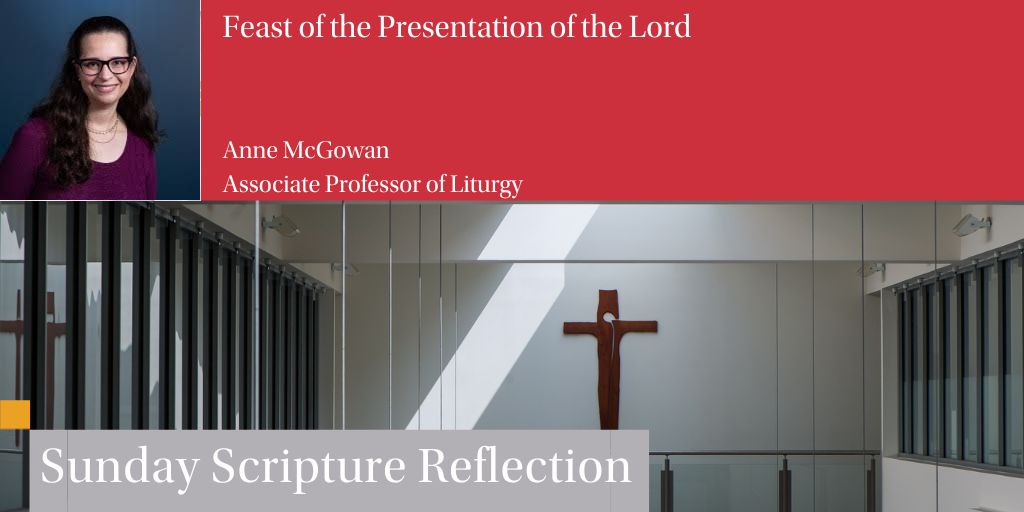
Readings:
Malachi 3:1-4
Psalm 24:7, 8, 9, 10
Hebrews 2:14-18
Luke 2:22-40 or 2:22-32
If Candlemas Day be fair and bright,
winter will have another flight.
If Candlemas Day be foul and rain,
winter has gone and will not come again.
Whether linked with a liturgical feast or a large furry rodent, people perceive the coming of the new day’s light on February 2 as a prognostication of what we might expect in days to come. Those who reside in the northern hemisphere begin noticing more minutes of daylight as time tilts toward the spring equinox (even if the corresponding consistent climb of temperature remains weeks away). The Church celebrates this feast of light forty days after Christmas, reminding us that the consequences of Christmas continue after Christ’s coming in the flesh as the world’s light and life through our own meeting him as a Messiah we can behold and even hold. The holy encounter of Simeon and Anna with Jesus in the Temple names the feast in the East: Hypapante (“meeting”). Simeon seeing God’s salvation through Jesus’ appearance in the Jerusalem Temple as “a light for revelation to the Gentiles, and glory for [God’s] people Israel” is another epiphany. The world is flooded with light for all to see, and so the Feast of the Presentation of the Lord became a day for blessing candles and processing with their radiance.
Just as Jesus came to enflame the hopes held by Simeon and Anna, so we can expect Christ’s coming to us in our own lives for the illumination of a dark world that longs for the redemption and rekindling Christ brings. Whether this next coming is, for us, a sudden shock, as the prophet Malachi intimates it will be, or a gentle arrival into an ordinary day, we become in our reception of the fiery light like doors that can reach high and fling wide so the king of glory may come in. Then let us also become windows that let Christ’s light shine out to the world! We have already welcomed Christ in before, “holding” his presence—in the Spirit—through our baptism, confirmation, and repeated reception of the Eucharist. Precisely because this same Christ “had to become like his brothers and sisters in every way, that he might be a merciful and faithful high priest before God,” so we now are continually capacitated and rebuilt to participate in Christ’s high priestly mission as we offer a sacrifice to the LORD of praise, of prayer, and patient waiting as we let Christ’s light refine and purify us and everyone else. And so we learn to shine.
Like Anna, who “worshiped night and day with fasting and prayer,” we should stand ready to meet the light in its fullness while rejoicing in the share of Christ’s light already entrusted to us.
In the progressive enlightenment blazing forth from baptism, members of the light-bearing Church carry their candles, turning toward the eternal procession they are exhorted to join:
You have been made light in Christ.
Walk always as children of light,
that persevering in faith
you may run to meet the Lord when he comes
with all the Saints in the heavenly court.
This is our destiny, and so this is a feast for us and for our salvation—a forecast of our future more reliable than the weather in February or March. So preached Saint Sophronius, a bishop of Jerusalem in the early seventh century, in a homily still heard today in the Office of Readings:
The light has come and has shone upon a world enveloped in shadows; the Dayspring from on high has visited us and given light to those who lived in darkness. This, then, is our feast, and we join in procession with lighted candles to reveal the light that has shone upon us and the glory that is yet to come to us through him. So let us hasten all together to meet our God.
The true light has come, the light that enlightens every [one] who is born into this world. Let all of us, my [brothers and sisters], be enlightened and made radiant by this light. Let all of us share in its splendor and be so filled with it that no one remains in the darkness. Let us be shining ourselves as we go together to meet and to receive with the aged Simeon the light whose brilliance is eternal. Rejoicing with Simeon [and Anna!], let us sing a hymn of thanksgiving to God, the Father of the light, who sent the true light to dispel the darkness and to give us all a share in his splendor.
Anne McGowan
Associate Professor of Liturgy
